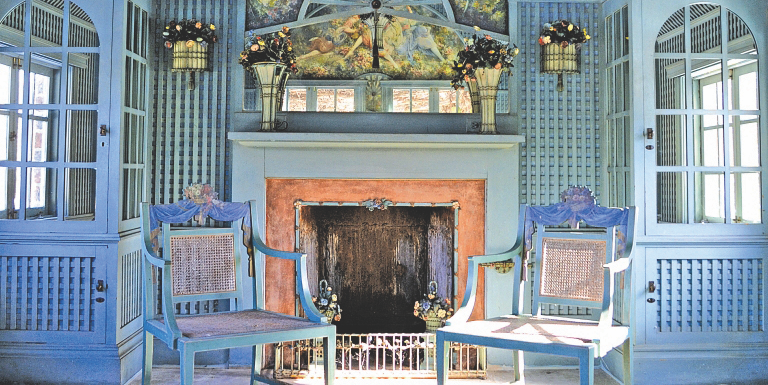The Fascinating History of an Elsie de Wolfe-Designed Tea House—Which Will Soon Open for Tours

- Oops!Something went wrong.Please try again later.
“Hearst Magazines and Verizon Media may earn commission or revenue on some items through the links below.”
"I’m going to make everything around me beautiful—that will be my life."
So said Elsie de Wolfe, America’s first interior designer, whose clients included Oscar Wilde, Condé Nast, the Duke and Duchess of Windsor, and members of the Frick, Morgan, and Vanderbilt dynasties. Although it’s been 71 years since she died at the age of 90, de Wolfe's impact remains undeniable—her 1913 book, The House in Good Taste, is still read by design lovers to this day, and, fortunately, a few of her designs have been preserved for the past century. One of those extraordinary artifacts is a quaint tea house that’s part of the Planting Fields Arboretum State Historic Park in Oyster Bay, New York. To learn more about this remarkable piece of design history, House Beautiful spoke to Gina Wouters, the Executive Director of the Planting Fields Foundation.
Although Elsie de Wolfe’s own residences in France and Manhattan no longer exist as they did when she decorated and lived in them, her creations for the Coes—an affluent family with ties to railroad and Standard Oil fortunes—are still intact. And, best of all, their former residence is now the Coe Hall Historic House Museum, and it’s open for tours year-round.
Built in 1915, the tea house at Planting Fields is part of the estate’s Italian Garden, where it was built for the Coe family to enjoy whenever they stayed here, in a Tudor Revival-style mansion that will leave you wondering if you’ve somehow ventured off to the English countryside. De Wolfe also designed Mai Coe’s dressing room on the second floor of Coe Hall.
Given that the Coes had five other residences, according to Wouters, they didn’t spend much of their time on Long Island. So, you might be wondering, what is the purpose of having such an impressive tea house there? Well, the tea house’s location, the Italian Garden, “was a favorite space of Mai Coe’s,” reveals Wouters. And, although there is no direct evidence as to how the Coes used this petite structure, we do know that “there was a direct view to the Italian Garden” from Mai Coe’s bedroom suite. We wish we could say the same for our own boudoirs!
Of course, it’s only customary for an affluent family to hire the best of the best, especially when it comes to interior decorators, which is why Elsie de Wolfe was enlisted to design this charming space. At the time this tea house was built 106 years ago, Lady Mendl—as de Wolfe was known following her marriage to British actor and diplomat Charles Mendl in 1926—“was the leading decorator of the time, and the Coes brought on the best designers, artists, architects, and artisans around on all aspects of the design of Planting Fields,” proclaims Wouters. “She was the tastemaker and having her design a space in one’s house showed how of the moment it was.”

De Wolfe didn't take on Planting Fields alone, though: The Olmsted brothers, John Charles Olmsted and Frederick Law Olmsted Jr., designed the Italian Garden in which the tea house is located, and American artist Everett Shinn was the mastermind behind the two murals and painted furniture within the tea house, which are still part of the seafoam blue space today. Shinn met de Wolfe, as well as renowned architect Stanford White, through mutual acquaintances in the theater world of New York City, which led to Shinn working on various projects with both design legends.
And although this remarkable tea house hasn’t been open to the public since 2014, it will once again have that honor very soon, as part of a new exhibit titled Everett Shinn: Operatics, which will run at Planting Fields from Wednesday, May 12th through Sunday, November 14th. Expect to see decorative murals, furnishings, paintings, drawings, musical instruments, and objects by Everett Shinn from the Planting Fields Foundation collection, as well as pieces from both public and private collections, some of which have never been on public display before.
If you, too, would like to make everything around you beautiful à la Elsie de Wolfe, plan your visit to Planting Fields here.
Follow House Beautiful on Instagram.
You Might Also Like

